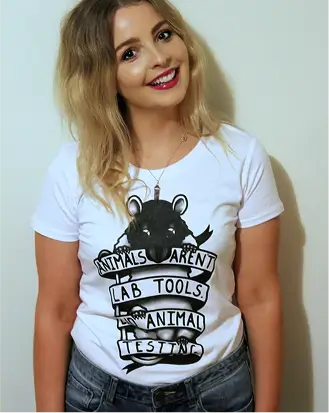Global Wins in Kind Education
Across the world, various regions and individual institutes are moving away from the harmful use of animals for teaching purposes.
These global wins are all significant steps towards a more ethical approach to education.
Join us in celebrating these achievements as we work together for a kinder, cruelty-free future in Aotearoa!
Dissection bans
In Belgium, there are guidelines against the use of animal dissections; these guidelines recommend that it should be respected if anyone (including teachers) doesn’t want to dissect animals.1 In 2008. a national agreement was set up between the Education and Training Department of the Flemish Community and an animal rights group called Gaia; this agreement encourages the use of alternatives instead of animal dissections.2
India banned the dissection of animals in zoology and life sciences university courses in 2014.3 Specifically, the Indian University Grants Commission has directed all universities to stop the dissection of animals at undergraduate and postgraduate levels4 and published a guideline on how they should approach this.5
The veterinary teaching at Tufts University was the first university in the USA to eliminate terminal laboratories from its curriculum in 1994. They even ethically source cadavers through a donation program for dissections in anatomy classes.6
Western University (USA) also proudly uses its “willed body” program to access cadavers for dissections ethically. Training is performed with inanimate and dynamic models. Live animals are only used to treat their naturally occurring diseases or for sterilisation.7
In April 2019, Brazil implemented a partial ban on animal use for education purposes. The use of animals in many practical classes at the undergraduate level and high school technical education is now prohibited. The ban refers to student practical classes for knowledge acquisition, and it is understood that this applies to practical classes within anatomy, pathology, physiology, and pharmacology at these levels. This means that it is illegal to use animal dissections to teach students about different anatomical structures at this level.8
Several German universities provide education without animal use, and several more at least provide opt-out alternatives.9
South Korea updated its Animal Protection Act, prohibiting dissection of vertebrate animals (including body parts) by minors. The update came into effect in June 2025.10
Other wins
In 1993, the Italian parliament passed a law that grants the right of any citizen to refuse to participate in any form of animal experimentation without penalty.11
In 2016, the Physicians Committee of Responsible Medicine (PCRM) reported that all surveyed U.S. and Canadian Medical Schools are now free of live animal use. There are no medical schools in these countries known to use live animals anymore.12
PCRM reported in 2018 that there are no known live animal labs used in Paediatrics Residency programs in the U.S. and Canada. That is 228 Programs using only non-animal teaching methods.13
Ross University School of Veterinary Medicine in the USA built its ethical clinical skills lab in 2010, set up to train future vets without using invasive procedures involving live animals. Prof. Andrew Knight has outlined what was involved in setting this laboratory up, running it and growing its teaching scope to include a wider range of surgical, medical and other clinical skills.14 This is showing promising results as demonstrated by the positive feedback received from students — A survey showed that 95% of students felt that the clinical skills lab had improved their psychomotor skills! This emphasises that when alternatives are used instead of live animals for training vet students, the same academic outcome can be reached or even exceeded. The current Academic Catalogue stresses the use of simulators and models and does not use terminal surgery.15
The College of Veterinary Medicine (Illinois, USA) reports that new students regularly choose this school because of their excellent Clinical Skills Lab.16 They dropped live-terminal training many years ago.
The Humane Society Veterinary Medical Association reports on their achievements in getting U.S. institutions to drop terminal surgeries in their teaching.17
International Veterinary Simulation in Teaching is an international group of veterinary doctors connecting through regular conferences to share and enhance knowledge around teaching through models and simulations.18
A law change in Pakistan includes banning live animal procedures in veterinary schools and the shooting of some animals. Salman Sufi, head of Prime Minister Shehbaz Sharif’s strategic reforms unit, said that the law would be enacted in Islamabad, and the federal government would encourage the provinces to implement it. A comprehensive law would be tabled in the next session of parliament for implementation at the national level.19 Furthermore, at the end of 2022, the Ministry of Federal Education and Professional Training and the Prime Minister launched the first Curriculum of Pakistan’s Animal Rights on the directives of Prime Minister Shehbaz Sharif for all of Islamabad’s private and public institutes, teaching children about animal care and compassion.20
Germany’s Animal Protection Law permits experimentation with live animals only at higher education institutions (not in schools).21
In NZ
There are no formal bans in place that prohibit animal dissections or the harmful use of animals for teaching purposes in NZ. However, some institutes such as Massey University, are utilising many animal-free methods to teach and train students.
We now know how Kiwis feel about the use of animals for teaching purposes thanks to a survey conducted by ANZCCART in 2023. This survey found that more than half of New Zealanders are not okay with animals being used for teaching; with the exception of mice and rats who were considered acceptable by 57% of people. Almost a quarter of New Zealanders considered any animal use for teaching unacceptable!22
- https://www.vob-ond.be/Ledenrubriek/Leden%20melden/Raamovereenkomst/index.html (last updated May 2025; Dutch)
- https://www.standaard.be/cnt/dmf06032008_047 (2008; Dutch)
- https://www.indiatoday.in/education-today/news/story/ugc-instructs-colleges-and-universities-to-ban-dissection-and-experimentation-on-animals-for-academic-purposes-203172-2014-08-07 (2014)
- https://www.ugc.ac.in/pdfnews/6819407_ugcletterzoology.pdf
- https://www.ugc.ac.in/pdfnews/6686154_guideline.pdf
- https://vet.tufts.edu/curriculum/animal-use-dvm-program (accessed July 2025)
- https://www.westernu.edu/veterinary/about-us/ (accessed July 2025)
- https://doi.org/10.1177/026119291804600402 (2018)
- https://www.satis-tierrechte.de/hochschul-wegweiser/ (accessed July 2025; German)
- https://law.go.kr/법령/동물보호법 (accessed July 2025)
- https://www.normattiva.it/uri-res/N2Ls?urn:nir:stato:legge:1993;413 (1993; Italian)
- http://www.pcrm.org/ethical-science/ethical-education-and-training/all-us-and-canadian-medical-schools-are-free-of-live-animal-use (last updated March 2024)
- http://www.pcrm.org/ethical-science/ethical-education-and-training/animal-use-in-allopathic-and-osteopathic-pediatrics-residency-programs-in-the-united-states-and-canada-an-ongoing-survey (last updated April 2020)
- https://doi.org/10.1177/026119291804600305 (2018)
- https://veterinary.rossu.edu/media/12201/academiccatalog.pdf (accessed July 2025)
- https://vetmed.illinois.edu/education/dvm-program/clinical-skills/ (accessed July 2025)
- https://www.humanevma.org/index.php?option=com_content&view=article&id=212:michigan_state_ends_terminal_surgeries&catid=23:students&Itemid=93 (accessed July 2025)
- https://www.vetedsimulation.com/about-us.pml (accessed July 2025)
- https://veganfta.com/2022/07/18/pakistan-veterinary-students-will-not-be-allowed-to-hurt-animals-while-in-training/ (2022)
- https://www.arabnews.pk/node/2213521/pakistan (2021)
- http://www.gesetze-im-internet.de/tierschg/BJNR012770972.html (§ 7a (1); last updated December 2022; German)
- https://www.anzccart.org.nz/pages/general-info (2023)





